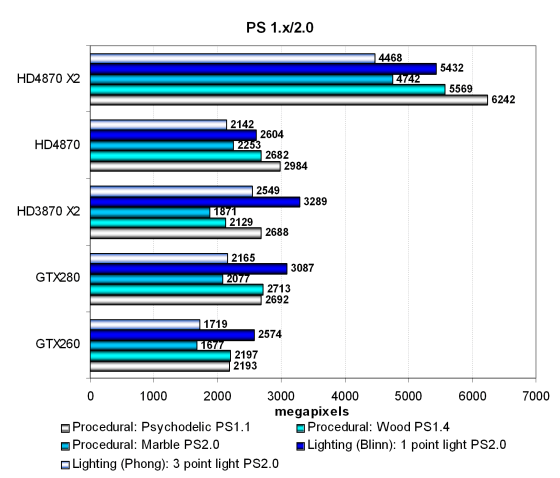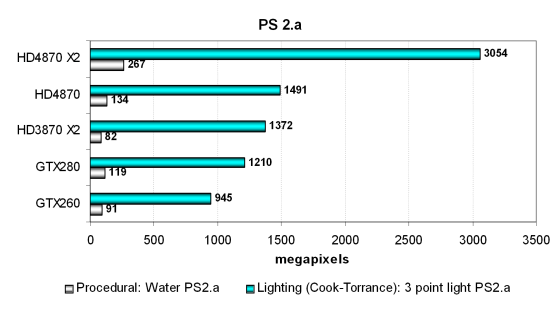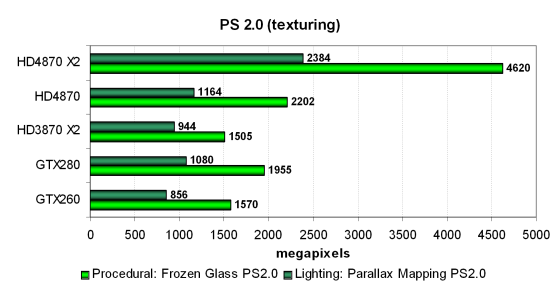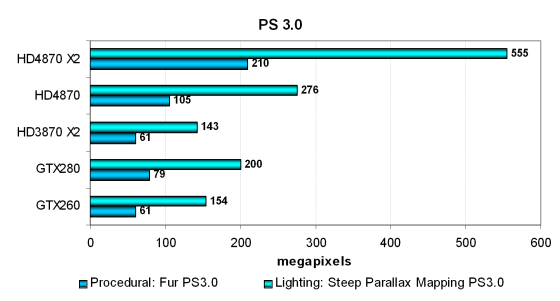DX9: Pixel Shaders Tests
The first group of pixel shaders to be reviewed here is too simple for modern GPUs. It includes various versions of pixel programs of relatively low complexity: 1.1, 1.4, and 2.0.
These tests are too easy for modern architectures, they are interesting only when architectures change. Even if we take into account that performance in simple tests is limited by texel rate, results of the dual-GPU card are approximately twice as high as those of the single-GPU solution. That's why HD 4870 X2 outperforms all NVIDIA cards in all our tasks, it's twice as fast as all the other cards or even faster. That's the effect of AFR and improved architecture of the RV770.
In more complex tests RADEON HD 4870 X2 also demonstrates excellent results, significantly outperforming its predecessors and competitors. The new single-GPU cards from NVIDIA looks much weaker in these tests, competing only with the single-GPU HD 4870. Let's have a look at results in more complex pixel programs of intermediate versions:
The same story here. AFR effectively doubles the frame rate in such synthetic tests and in the procedural water test, which depends much on texturing performance and uses dependent texture lookups of high nesting depth. The cards line up according to their texel rates here. So the new dual-GPU card is 2.2-2.5 times as fast as both cards from NVIDIA, and it's exactly twice as fast as HD 4870.
The second test generates a heavier load on arithmetic units, and it favors AMD architectures with lots of streaming processors. The new solution from AMD again demonstrates maximum results here, much higher than GeForce GTX 260/280 and HD 4870. AFR again provides a two-fold performance advantage for the dual-RV770 card over the single-GPU solution.
DX9: New Pixel Shaders Tests
These tests of DirectX 9 pixel shaders are even more complex, they are divided into two categories. We'll start with easier shaders - SM 2.0:
- Parallax Mapping -- a texturing method used in many modern games
- Frozen Glass -- a complex procedural texture that visualizes frozen glass with adjustable parameters
There are two modifications of these shaders: arithmetic intensive and texture sampling intensive. Let's analyze arithmetic-intensive modifications, they are more promising from the point of view of future applications:
GPU balance is important in these arithmetic tests, which depend primarily on the frequency of shader units and texturing speed. Performance of graphics cards in the Frozen Glass test is limited not only by arithmetic speed, but also by texel rate. So the old dual-GPU RADEON card demonstrates a weak result. And the new cards perform very well. The single-GPU HD 4870 is faster than GTX 260 or GTX 280. And the dual-GPU card is twice as fast (AFR).
The new HD 4800 solutions preserve their leadership in the second Parallax Mapping test as well. Single-GPU HD 4870 outperforms both cards from NVIDIA, and the dual-GPU card again shows twice as many frames per second. Let's analyze results obtained in the texture sampling intensive tests, where we may obtain even more interesting results:
On the whole, it's almost the same story here. RADEON HD 4870 outperforms GeForce GTX 260 and GTX 280 in both tests. And HD 4870 X2 is still very strong. However, the layout of forces has changed a little because of the bias to texturing performance. So HD 3870 X2 demonstrates a tad weaker results.
Let's have a look at results of another two pixel shader tests -- SM 3.0. They are the most complex of all our tests for Direct3D 9 pixel shaders. The tests load ALUs and texture units heavily. Both shader programs are complex, long, and include a lot of branches:
- Steep Parallax Mapping is a much heavier modification of parallax mapping
- Fur -- a procedural shader that visualizes fur
We are again surprised at how good the new architecture from AMD is in these tests. It forms a contrast to results of the previous solutions, which were outperformed by NVIDIA cards, even two GPUs in HD 3870 X2 were of little help here. And HD 4870 is way faster than all its competitors. But today we are testing HD 4870 X2, which is 2.7-2.8 times as fast as the top GeForce GTX 280! We'll see what happens in DX10, where AMD cards apparently fared worse in previous reviews. Has anything changed since the last article?
Write a comment below. No registration needed!





